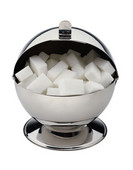
MONDAY, March 7 (HealthDay News) –Taste cells apparently host more sugar detectors than previously thought, including ones formerly thought to exist only in the pancreas and intestines, new research suggests.
The finding could lead to the development of new interventions designed to help prevent overeating, the study authors say.
“Detecting the sweetness of nutritive sugars is one of the most important tasks of our taste cells,” senior author Dr. Robert F. Margolskee, a molecular neurobiologist at the Monell Chemicals Senses Center in Philadephia, said in a news release. “Many of us eat too much sugar and to help limit overconsumption, we need to better understand how a sweet taste cell ‘knows’ something is sweet.”
Margolskee and his colleagues report their observations in this week’s issue of the Proceedings of the National Academy of Sciences.
Until now, investigators had focused on one particular taste cell receptor (known as T1r2+T1r3) as the main detector of all things sweet, including both natural sugars and artificial sweeteners.
This sensor, however, did not appear to account for all aspects of sweetness detection.
So, the authors harnessed high-tech molecular and cellular lab methods to explore whether or not additional sugar sensors — those central to the digestive process that takes place in both the intestine and pancreas — might also be present in taste cells.
The result: those same sugar sensors were thriving in taste cells. In fact, several sugar sensors found in the intestine and pancreas were fingered as being present in the same taste cells that house the well-known T1r2+T1r3 receptor.
For example, the newly located taste cell receptor known as SGLT1 (previously detected solely in the intestine) was found to account for the sweet taste that registers when consuming a pinch of table salt. Another newly found sensor, known as KATP and previously attributed solely to the pancreas, is thought to play a role in restricting taste cell sensitivity to sugar to discourage overconsumption of sweetened foods.
“Sweet taste cells have turned out to be quite complex. The presence of the KATP channel suggests that taste cells may play a role in regulating our sensitivity to sweet taste under different nutritional conditions,” first author Karen K. Yee, a cellular physiologist at Monell, said in the same news release. “This knowledge may someday help us understand how to limit overconsumption of sweet foods.”
More information
For more on the sense of taste, visit the National Institute on Deafness and Other Communication Disorders.

